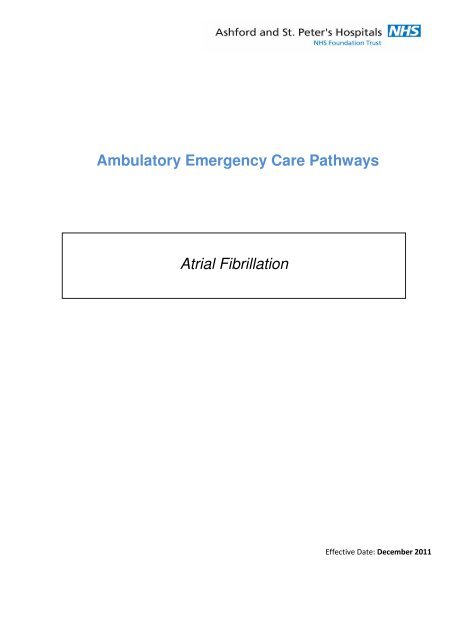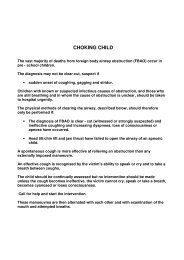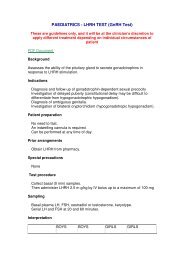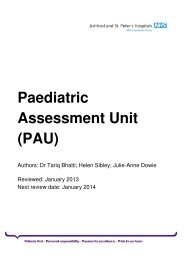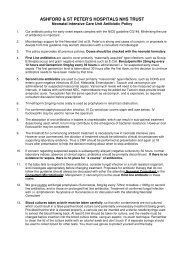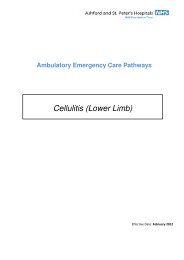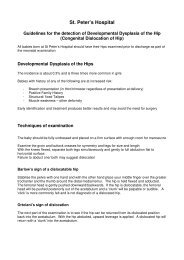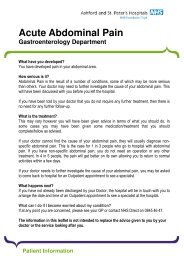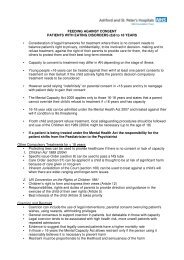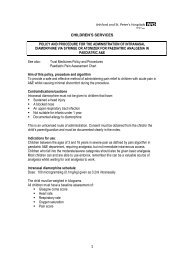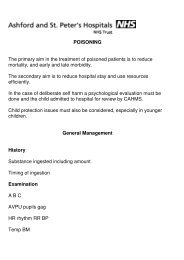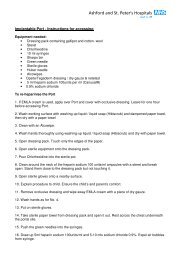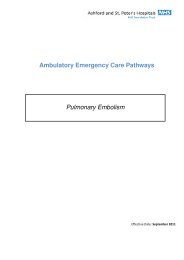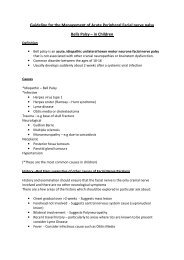AECP - AF.pdf - Ashford and St. Peter's Hospitals NHS Trust
AECP - AF.pdf - Ashford and St. Peter's Hospitals NHS Trust
AECP - AF.pdf - Ashford and St. Peter's Hospitals NHS Trust
Create successful ePaper yourself
Turn your PDF publications into a flip-book with our unique Google optimized e-Paper software.
Ambulatory Emergency Care Pathways<br />
Atrial Fibrillation<br />
Effective Date: December 2011
Content Summary<br />
Ref Title Description<br />
1<br />
2<br />
3<br />
4<br />
5<br />
Condition Details<br />
Pathway Algorithm<br />
Patient Criteria<br />
Patient Information<br />
KPIs<br />
Identifies pathway details <strong>and</strong> clinical sign-off<br />
Identifies the pathway to follow to identify patients suitable for Ambulatory Care<br />
Criteria for patients appropriate for the pathway<br />
Identifies Patient Information leaflets for issue to patients regarding their pathway<br />
Identifies how the pathways are measured
1. Condition Details<br />
ay Details<br />
Details<br />
Sign Off:<br />
Condition Details Summary<br />
HRG/ICD-10 Codes<br />
Data<br />
(Baseline using 2010/11 outturn)<br />
EB07I, EB07H / I471, I479, I48X, I495, I498, I499,<br />
R000, R002, R008<br />
Total Patients per Month (Avg) 37.33<br />
Bed Days Utilised per Month (Avg) 93.50<br />
Number of Beds Utilised per Month (Avg) 0.26<br />
Average Length of <strong>St</strong>ay 2.5<br />
Potential Percentage suitable for ambulatory care 30-60%<br />
Pathway Designed by Clinical Subject Matter Expert Signed<br />
Pathway Approved by Specialty Lead Signed<br />
Pathway Authorised by Divisional Director Signed<br />
Print<br />
Print<br />
Print<br />
1: P<br />
1:<br />
Pat<br />
hw<br />
ay<br />
Det<br />
ails<br />
1:<br />
Pat<br />
hw
2. Pathway Algorithm<br />
Atrial Fibrillation<br />
Discharge Patient<br />
- Refer to Dr. Kaba’s Arrhythmia Clinic as a New Outpatient; include a copy of the ECG during <strong>AF</strong><br />
- Continue Bisoprolol (or digoxin)<br />
- Issue Patient Information<br />
- Letter to GP to check pulse, BP <strong>and</strong> ECG in 3-4 days<br />
- Refer to anticoagulation clinic if appropriate<br />
- “Tick” APD box on CAS form<br />
Patient Presents with:<br />
Suspected Atrial Fibrillation<br />
History & Examination<br />
(Including basic observations)<br />
Investigations, including<br />
12-lead ECG & Routine Bloods<br />
ECG Confirmed Atrial Fibrillation<br />
Yes<br />
Red Flags:<br />
History of loss of consciousness or BP>>> 110 , administer Bisoprolol 2.5mg - 5mg if no contraindications , otherwise<br />
digoxin loading <strong>and</strong> maintenance dosing<br />
2) If CHADSVASC > 2 then consider anticoagulation if no contraindications; if<br />
CHADSVASC
3. Patient Criteria<br />
Red Flags - Exclude the following Patients <strong>and</strong> Admit:<br />
History of loss of consciousness<br />
BP < 100/60<br />
Ischaemic changes on ECG<br />
HR
4. Patient Information<br />
Atrial fibrillation<br />
An irregular pulse could be a sign that you have an abnormal heart rhythm. Atrial Fibrillation<br />
(<strong>AF</strong>) is one of the most common forms of an abnormal heart rhythm <strong>and</strong> a major cause of<br />
stroke.<br />
That's why it's important to find out if you have it, because you can get effective treatment to reduce<br />
the risk of stroke.<br />
Normally, your heart’s natural pacemaker sends out regular electrical impulses. <strong>AF</strong> happens when<br />
those impulses fire off from different places in the atria (the top chambers of the heart) in a<br />
disorganised way.<br />
People with <strong>AF</strong> have an irregular <strong>and</strong> sometimes fast pulse. You can check to see if you might have<br />
<strong>AF</strong> simply by feeling your pulse.<br />
Around 800,000 people in the UK have <strong>AF</strong> - roughly one in 100 - <strong>and</strong> mostly aged 55 <strong>and</strong> over.<br />
What causes <strong>AF</strong>?<br />
Causes include high blood pressure, heart valve disease, thyrotoxicosis (overactive thyroid gl<strong>and</strong>) <strong>and</strong> excess<br />
alcohol consumption.<br />
It’s also associated with coronary heart disease. But in many patients no underlying cause can be found. Sometimes<br />
the <strong>AF</strong> can be resolved once the underlying condition has been dealt with.
What are the symptoms of <strong>AF</strong>?<br />
Symptoms can include palpitation (being aware of your heart beat), tiredness, shortness of breath, dizziness or<br />
feeling faint. However, some people only have mild symptoms, while other people have no symptoms at all.<br />
How can <strong>AF</strong> be detected?<br />
<strong>and</strong> beats may be variable in strength.<br />
<strong>AF</strong> can be detected by feeling the pulse at your wrist. The pulse will feel irregular<br />
Some people don’t realise they have <strong>AF</strong>. It’s only discovered when they have a pulse check or ECG (a test which<br />
records the electrical activity of the heart).<br />
Make sure you know your pulse<br />
If your pulse is irregular or if you’re concerned in any way about your pulse you should make an appointment to see<br />
your GP.<br />
Is an irregular pulse always due to <strong>AF</strong>?<br />
Occasional irregularities such as missed beats or extra beats are very common <strong>and</strong> usually nothing to worry about.<br />
<strong>AF</strong> on the other h<strong>and</strong> is continuously irregular with no pattern to it at all.<br />
What are the complications of <strong>AF</strong>?<br />
It can increase the risk of a blood clot forming inside the chambers of the<br />
heart, which can lead to a stroke. <strong>AF</strong> increases stroke risk by around four to<br />
five times.<br />
Although <strong>AF</strong> can greatly increase the risk of stroke, there are other factors that<br />
can contribute to a stroke. These include smoking, high cholesterol, high blood<br />
pressure, physical inactivity, being overweight <strong>and</strong> diabetes.<br />
With appropriate treatment the risk of stroke, can be substantially reduced. An anticoagulant (blood thinner) drug<br />
called Warfarin is the most effective treatment to reduce the risk of stroke in people with <strong>AF</strong>.
What should you do if your pulse is irregular?<br />
If your pulse is irregular or if you’re concerned in any way about your pulse you should make an appointment to see<br />
your GP.<br />
A quick guide to checking your pulse<br />
Checking your pulse<br />
Our senior Cardiac Nurse, Ellen Mason, shows you how to check your pulse.<br />
1. Put one of your h<strong>and</strong>s out so you’re looking at your palm.<br />
2. Use the index/first finger <strong>and</strong> middle finger of your other h<strong>and</strong> <strong>and</strong> place the pads of these fingers on the inside<br />
of your wrist.<br />
You should place them at the base of your thumb near where the strap of a watch would sit.<br />
3. Press lightly <strong>and</strong> feel the pulse. If you can’t feel anything press slightly harder or move your fingers around until<br />
you feel your pulse.<br />
4. Once you’ve found your pulse, continue to feel it for about 20-30 seconds.Feel the rhythm of the pulse <strong>and</strong> check<br />
if it’s regular or irregular.<br />
More information<br />
Arrhythmia Alliance<br />
Promoting better underst<strong>and</strong>ing, diagnosis, treatment <strong>and</strong> quality of life for individuals with cardiac arrhythmias.<br />
Tel: 01789 450787<br />
Atrial Fibrillation Association<br />
Providing information, support <strong>and</strong> access to established, new <strong>and</strong> innovative treatments for Atrial Fibrillation.<br />
Tel: 01789 451837<br />
What happens next?<br />
You have been referred to a specialist clinic at the hospital where your doctor will review your case<br />
<strong>and</strong> will discuss any further treatments that may be required.<br />
What can I do if I become worried about my condition?<br />
If at any point you are concerned about your condition, please see your GP or contact <strong>NHS</strong> Direct<br />
on 0845 46 47. If you have any loss of consciousness, go to A&E immediately.
The information in this leaflet is not intended to replace the advice given to you by your<br />
doctor or the service looking after you.
5. KPIs<br />
KPIs Description<br />
Core KPIs<br />
Other KPIs<br />
Reduction in the number of patients<br />
requiring a stay of more than 24 hours (i.e.<br />
a 0-Day LoS)<br />
Reduction in the Avg number of Bed Days<br />
utilised for the condition<br />
How it will be<br />
measured<br />
• Above Min <strong>and</strong> Max figures are part year effects for 2011/12 based on month of implementation<br />
Baseline<br />
(2010/11)<br />
At Min % At Max %<br />
PAS 448 34 67<br />
PAS 1122 84 168<br />
Reduction in Bed Numbers PAS 3.07 0.23 0.46<br />
Scope Scope: Patients entering the <strong>AECP</strong> Pathway at <strong>St</strong>. Peter’s Hospital<br />
Governance Governance: Reports to the Unscheduled Care Programme Board <strong>and</strong> Divisional Performance Review Meetings


